Comprehensive Report: Travel and Tourism Sector Analysis
VerifiedAdded on 2020/01/28
|8
|2370
|138
Report
AI Summary
This report provides a comprehensive analysis of the travel and tourism sector, beginning with its historical development and evolution. It explores the sector's structure, including key elements like distribution chains, visitor attractions, and the role of government agencies and tour operators, specifically referencing the TUI Group. The report then delves into factors affecting tourism demand, such as income levels, customer preferences, and technology. It further examines supply changes to meet demand fluctuations. Finally, the report assesses the positive and negative economic, environmental, and social impacts of tourism, offering strategies to minimize negative effects and maximize positive outcomes, concluding with a discussion of the sector's overall importance and future prospects.
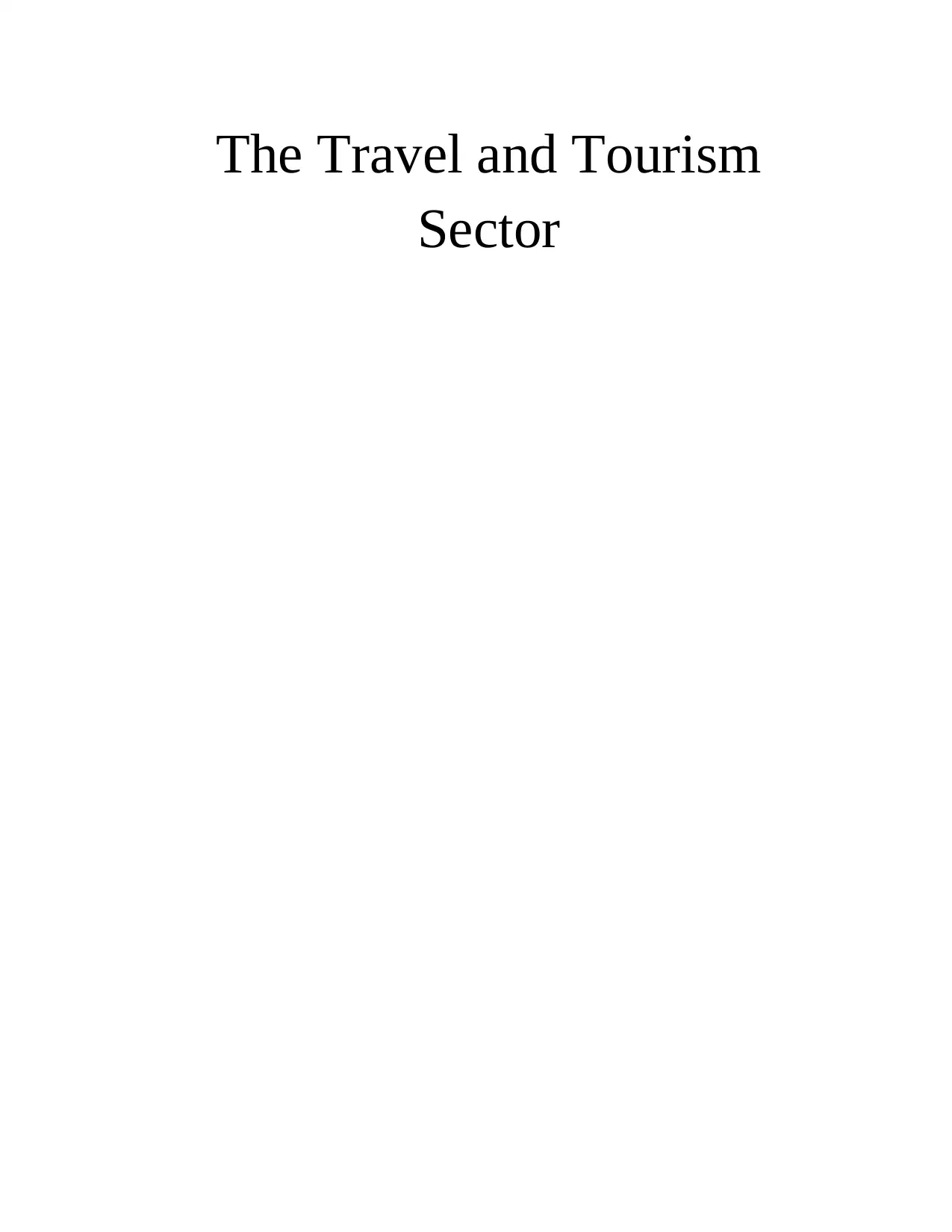
The Travel and Tourism
Sector
Sector
Paraphrase This Document
Need a fresh take? Get an instant paraphrase of this document with our AI Paraphraser
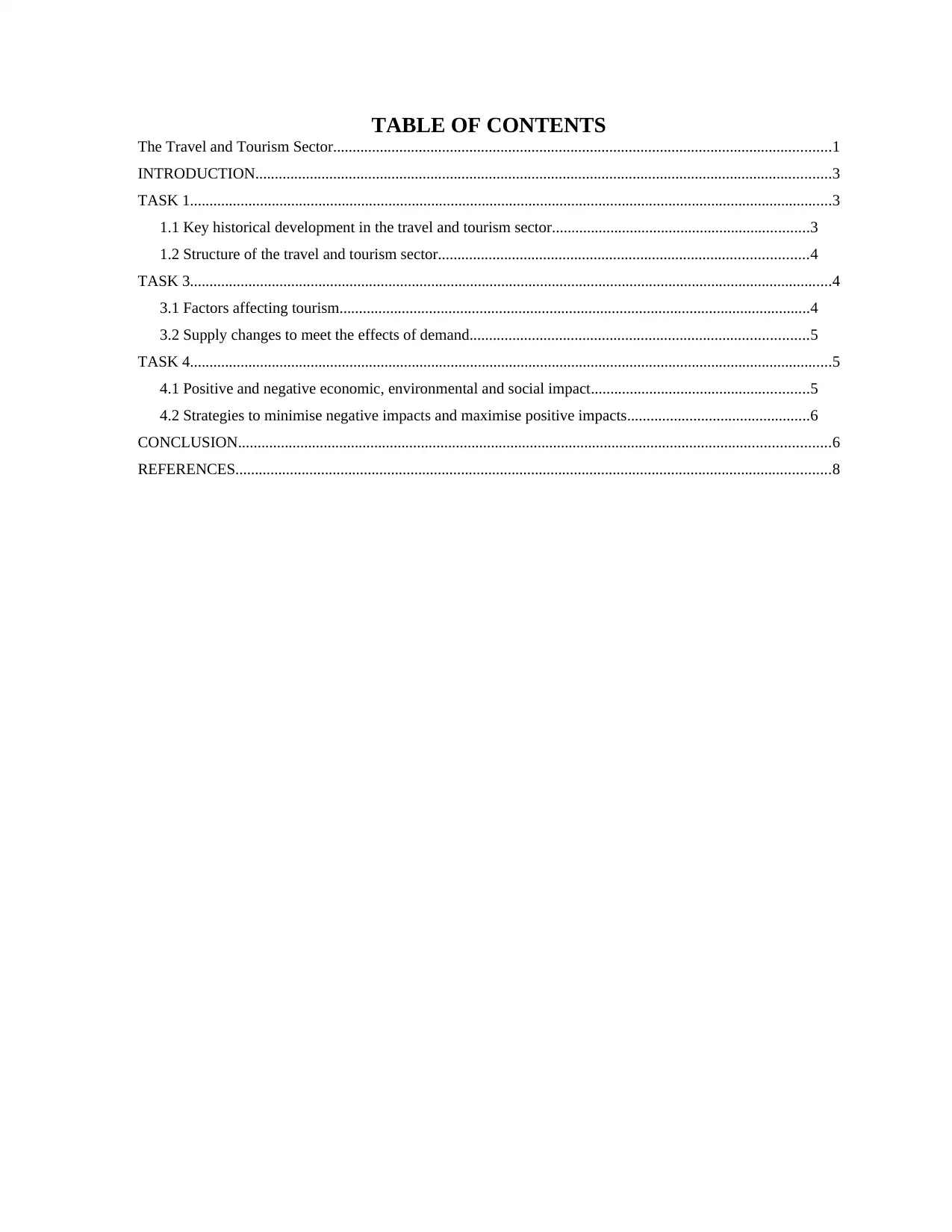
TABLE OF CONTENTS
The Travel and Tourism Sector................................................................................................................................1
INTRODUCTION....................................................................................................................................................3
TASK 1.....................................................................................................................................................................3
1.1 Key historical development in the travel and tourism sector..................................................................3
1.2 Structure of the travel and tourism sector...............................................................................................4
TASK 3.....................................................................................................................................................................4
3.1 Factors affecting tourism.........................................................................................................................4
3.2 Supply changes to meet the effects of demand.......................................................................................5
TASK 4.....................................................................................................................................................................5
4.1 Positive and negative economic, environmental and social impact........................................................5
4.2 Strategies to minimise negative impacts and maximise positive impacts...............................................6
CONCLUSION........................................................................................................................................................6
REFERENCES.........................................................................................................................................................8
The Travel and Tourism Sector................................................................................................................................1
INTRODUCTION....................................................................................................................................................3
TASK 1.....................................................................................................................................................................3
1.1 Key historical development in the travel and tourism sector..................................................................3
1.2 Structure of the travel and tourism sector...............................................................................................4
TASK 3.....................................................................................................................................................................4
3.1 Factors affecting tourism.........................................................................................................................4
3.2 Supply changes to meet the effects of demand.......................................................................................5
TASK 4.....................................................................................................................................................................5
4.1 Positive and negative economic, environmental and social impact........................................................5
4.2 Strategies to minimise negative impacts and maximise positive impacts...............................................6
CONCLUSION........................................................................................................................................................6
REFERENCES.........................................................................................................................................................8
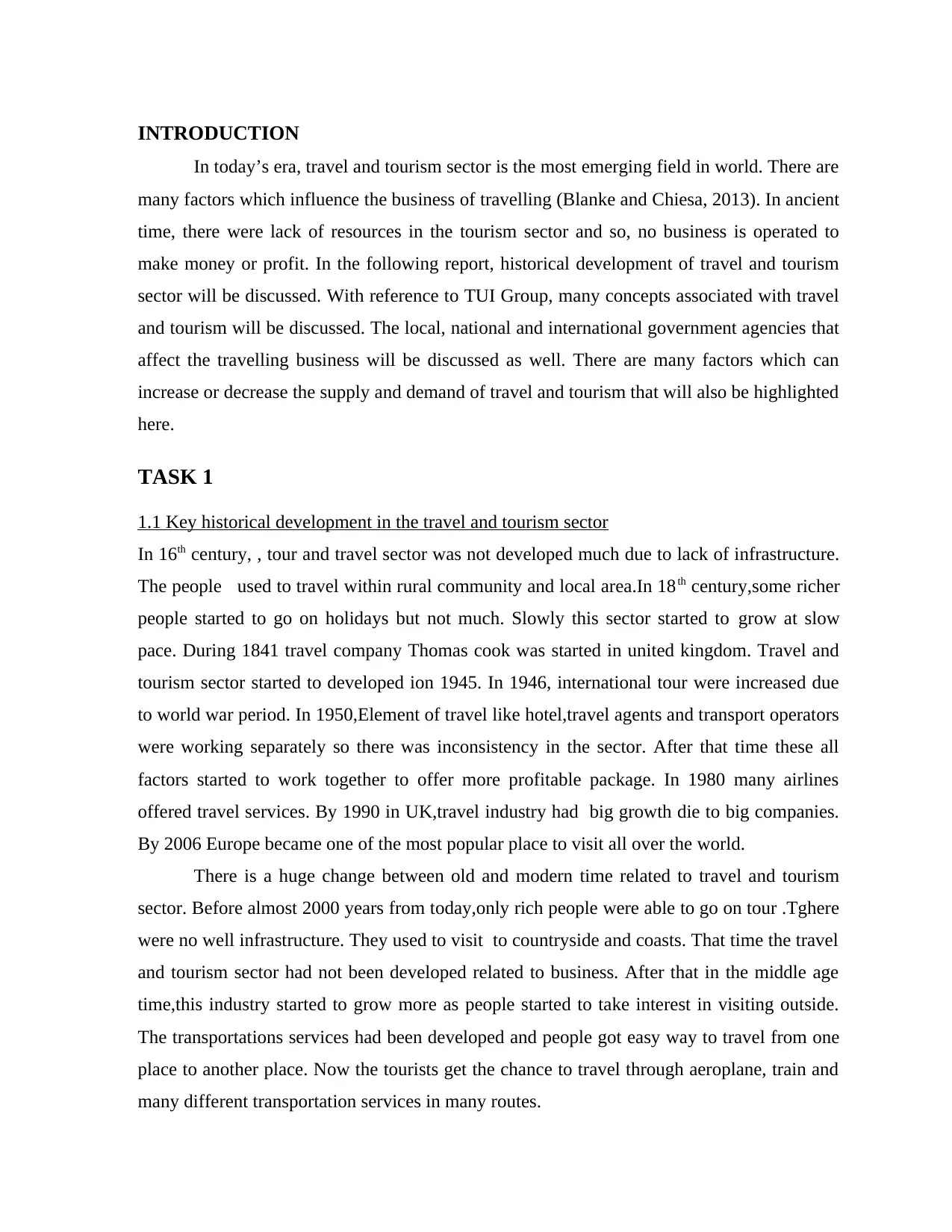
INTRODUCTION
In today’s era, travel and tourism sector is the most emerging field in world. There are
many factors which influence the business of travelling (Blanke and Chiesa, 2013). In ancient
time, there were lack of resources in the tourism sector and so, no business is operated to
make money or profit. In the following report, historical development of travel and tourism
sector will be discussed. With reference to TUI Group, many concepts associated with travel
and tourism will be discussed. The local, national and international government agencies that
affect the travelling business will be discussed as well. There are many factors which can
increase or decrease the supply and demand of travel and tourism that will also be highlighted
here.
TASK 1
1.1 Key historical development in the travel and tourism sector
In 16th century, , tour and travel sector was not developed much due to lack of infrastructure.
The people used to travel within rural community and local area.In 18th century,some richer
people started to go on holidays but not much. Slowly this sector started to grow at slow
pace. During 1841 travel company Thomas cook was started in united kingdom. Travel and
tourism sector started to developed ion 1945. In 1946, international tour were increased due
to world war period. In 1950,Element of travel like hotel,travel agents and transport operators
were working separately so there was inconsistency in the sector. After that time these all
factors started to work together to offer more profitable package. In 1980 many airlines
offered travel services. By 1990 in UK,travel industry had big growth die to big companies.
By 2006 Europe became one of the most popular place to visit all over the world.
There is a huge change between old and modern time related to travel and tourism
sector. Before almost 2000 years from today,only rich people were able to go on tour .Tghere
were no well infrastructure. They used to visit to countryside and coasts. That time the travel
and tourism sector had not been developed related to business. After that in the middle age
time,this industry started to grow more as people started to take interest in visiting outside.
The transportations services had been developed and people got easy way to travel from one
place to another place. Now the tourists get the chance to travel through aeroplane, train and
many different transportation services in many routes.
In today’s era, travel and tourism sector is the most emerging field in world. There are
many factors which influence the business of travelling (Blanke and Chiesa, 2013). In ancient
time, there were lack of resources in the tourism sector and so, no business is operated to
make money or profit. In the following report, historical development of travel and tourism
sector will be discussed. With reference to TUI Group, many concepts associated with travel
and tourism will be discussed. The local, national and international government agencies that
affect the travelling business will be discussed as well. There are many factors which can
increase or decrease the supply and demand of travel and tourism that will also be highlighted
here.
TASK 1
1.1 Key historical development in the travel and tourism sector
In 16th century, , tour and travel sector was not developed much due to lack of infrastructure.
The people used to travel within rural community and local area.In 18th century,some richer
people started to go on holidays but not much. Slowly this sector started to grow at slow
pace. During 1841 travel company Thomas cook was started in united kingdom. Travel and
tourism sector started to developed ion 1945. In 1946, international tour were increased due
to world war period. In 1950,Element of travel like hotel,travel agents and transport operators
were working separately so there was inconsistency in the sector. After that time these all
factors started to work together to offer more profitable package. In 1980 many airlines
offered travel services. By 1990 in UK,travel industry had big growth die to big companies.
By 2006 Europe became one of the most popular place to visit all over the world.
There is a huge change between old and modern time related to travel and tourism
sector. Before almost 2000 years from today,only rich people were able to go on tour .Tghere
were no well infrastructure. They used to visit to countryside and coasts. That time the travel
and tourism sector had not been developed related to business. After that in the middle age
time,this industry started to grow more as people started to take interest in visiting outside.
The transportations services had been developed and people got easy way to travel from one
place to another place. Now the tourists get the chance to travel through aeroplane, train and
many different transportation services in many routes.
⊘ This is a preview!⊘
Do you want full access?
Subscribe today to unlock all pages.

Trusted by 1+ million students worldwide
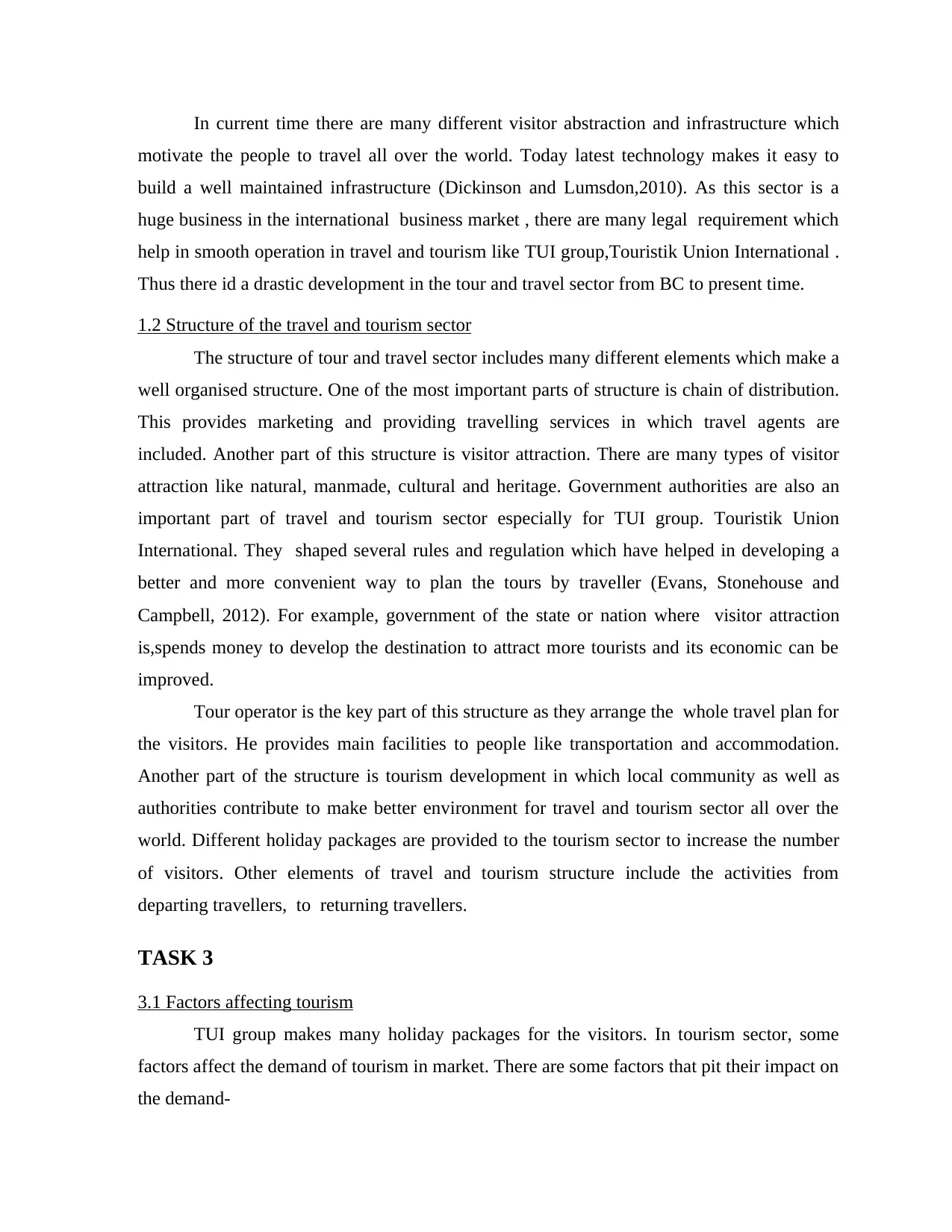
In current time there are many different visitor abstraction and infrastructure which
motivate the people to travel all over the world. Today latest technology makes it easy to
build a well maintained infrastructure (Dickinson and Lumsdon,2010). As this sector is a
huge business in the international business market , there are many legal requirement which
help in smooth operation in travel and tourism like TUI group,Touristik Union International .
Thus there id a drastic development in the tour and travel sector from BC to present time.
1.2 Structure of the travel and tourism sector
The structure of tour and travel sector includes many different elements which make a
well organised structure. One of the most important parts of structure is chain of distribution.
This provides marketing and providing travelling services in which travel agents are
included. Another part of this structure is visitor attraction. There are many types of visitor
attraction like natural, manmade, cultural and heritage. Government authorities are also an
important part of travel and tourism sector especially for TUI group. Touristik Union
International. They shaped several rules and regulation which have helped in developing a
better and more convenient way to plan the tours by traveller (Evans, Stonehouse and
Campbell, 2012). For example, government of the state or nation where visitor attraction
is,spends money to develop the destination to attract more tourists and its economic can be
improved.
Tour operator is the key part of this structure as they arrange the whole travel plan for
the visitors. He provides main facilities to people like transportation and accommodation.
Another part of the structure is tourism development in which local community as well as
authorities contribute to make better environment for travel and tourism sector all over the
world. Different holiday packages are provided to the tourism sector to increase the number
of visitors. Other elements of travel and tourism structure include the activities from
departing travellers, to returning travellers.
TASK 3
3.1 Factors affecting tourism
TUI group makes many holiday packages for the visitors. In tourism sector, some
factors affect the demand of tourism in market. There are some factors that pit their impact on
the demand-
motivate the people to travel all over the world. Today latest technology makes it easy to
build a well maintained infrastructure (Dickinson and Lumsdon,2010). As this sector is a
huge business in the international business market , there are many legal requirement which
help in smooth operation in travel and tourism like TUI group,Touristik Union International .
Thus there id a drastic development in the tour and travel sector from BC to present time.
1.2 Structure of the travel and tourism sector
The structure of tour and travel sector includes many different elements which make a
well organised structure. One of the most important parts of structure is chain of distribution.
This provides marketing and providing travelling services in which travel agents are
included. Another part of this structure is visitor attraction. There are many types of visitor
attraction like natural, manmade, cultural and heritage. Government authorities are also an
important part of travel and tourism sector especially for TUI group. Touristik Union
International. They shaped several rules and regulation which have helped in developing a
better and more convenient way to plan the tours by traveller (Evans, Stonehouse and
Campbell, 2012). For example, government of the state or nation where visitor attraction
is,spends money to develop the destination to attract more tourists and its economic can be
improved.
Tour operator is the key part of this structure as they arrange the whole travel plan for
the visitors. He provides main facilities to people like transportation and accommodation.
Another part of the structure is tourism development in which local community as well as
authorities contribute to make better environment for travel and tourism sector all over the
world. Different holiday packages are provided to the tourism sector to increase the number
of visitors. Other elements of travel and tourism structure include the activities from
departing travellers, to returning travellers.
TASK 3
3.1 Factors affecting tourism
TUI group makes many holiday packages for the visitors. In tourism sector, some
factors affect the demand of tourism in market. There are some factors that pit their impact on
the demand-
Paraphrase This Document
Need a fresh take? Get an instant paraphrase of this document with our AI Paraphraser
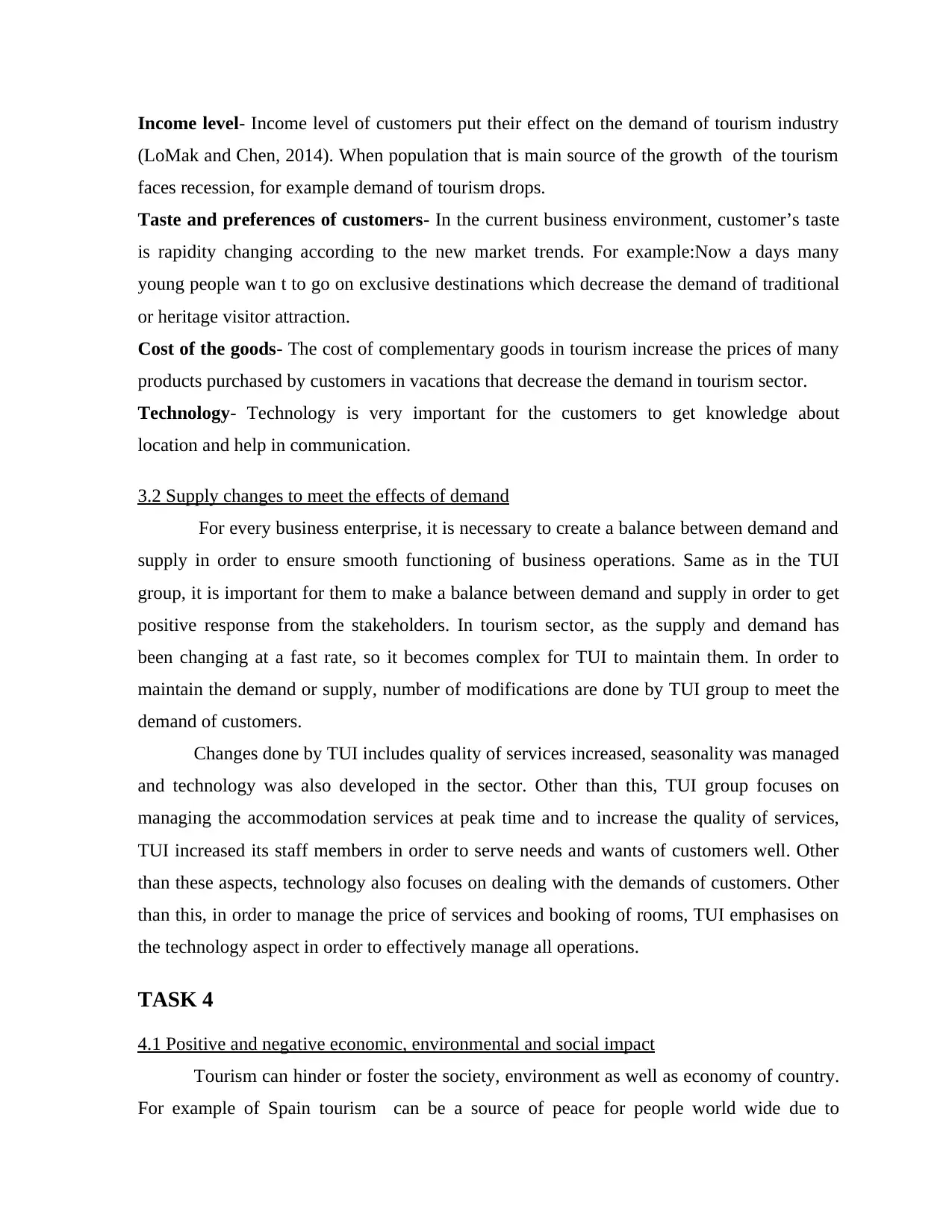
Income level- Income level of customers put their effect on the demand of tourism industry
(LoMak and Chen, 2014). When population that is main source of the growth of the tourism
faces recession, for example demand of tourism drops.
Taste and preferences of customers- In the current business environment, customer’s taste
is rapidity changing according to the new market trends. For example:Now a days many
young people wan t to go on exclusive destinations which decrease the demand of traditional
or heritage visitor attraction.
Cost of the goods- The cost of complementary goods in tourism increase the prices of many
products purchased by customers in vacations that decrease the demand in tourism sector.
Technology- Technology is very important for the customers to get knowledge about
location and help in communication.
3.2 Supply changes to meet the effects of demand
For every business enterprise, it is necessary to create a balance between demand and
supply in order to ensure smooth functioning of business operations. Same as in the TUI
group, it is important for them to make a balance between demand and supply in order to get
positive response from the stakeholders. In tourism sector, as the supply and demand has
been changing at a fast rate, so it becomes complex for TUI to maintain them. In order to
maintain the demand or supply, number of modifications are done by TUI group to meet the
demand of customers.
Changes done by TUI includes quality of services increased, seasonality was managed
and technology was also developed in the sector. Other than this, TUI group focuses on
managing the accommodation services at peak time and to increase the quality of services,
TUI increased its staff members in order to serve needs and wants of customers well. Other
than these aspects, technology also focuses on dealing with the demands of customers. Other
than this, in order to manage the price of services and booking of rooms, TUI emphasises on
the technology aspect in order to effectively manage all operations.
TASK 4
4.1 Positive and negative economic, environmental and social impact
Tourism can hinder or foster the society, environment as well as economy of country.
For example of Spain tourism can be a source of peace for people world wide due to
(LoMak and Chen, 2014). When population that is main source of the growth of the tourism
faces recession, for example demand of tourism drops.
Taste and preferences of customers- In the current business environment, customer’s taste
is rapidity changing according to the new market trends. For example:Now a days many
young people wan t to go on exclusive destinations which decrease the demand of traditional
or heritage visitor attraction.
Cost of the goods- The cost of complementary goods in tourism increase the prices of many
products purchased by customers in vacations that decrease the demand in tourism sector.
Technology- Technology is very important for the customers to get knowledge about
location and help in communication.
3.2 Supply changes to meet the effects of demand
For every business enterprise, it is necessary to create a balance between demand and
supply in order to ensure smooth functioning of business operations. Same as in the TUI
group, it is important for them to make a balance between demand and supply in order to get
positive response from the stakeholders. In tourism sector, as the supply and demand has
been changing at a fast rate, so it becomes complex for TUI to maintain them. In order to
maintain the demand or supply, number of modifications are done by TUI group to meet the
demand of customers.
Changes done by TUI includes quality of services increased, seasonality was managed
and technology was also developed in the sector. Other than this, TUI group focuses on
managing the accommodation services at peak time and to increase the quality of services,
TUI increased its staff members in order to serve needs and wants of customers well. Other
than these aspects, technology also focuses on dealing with the demands of customers. Other
than this, in order to manage the price of services and booking of rooms, TUI emphasises on
the technology aspect in order to effectively manage all operations.
TASK 4
4.1 Positive and negative economic, environmental and social impact
Tourism can hinder or foster the society, environment as well as economy of country.
For example of Spain tourism can be a source of peace for people world wide due to
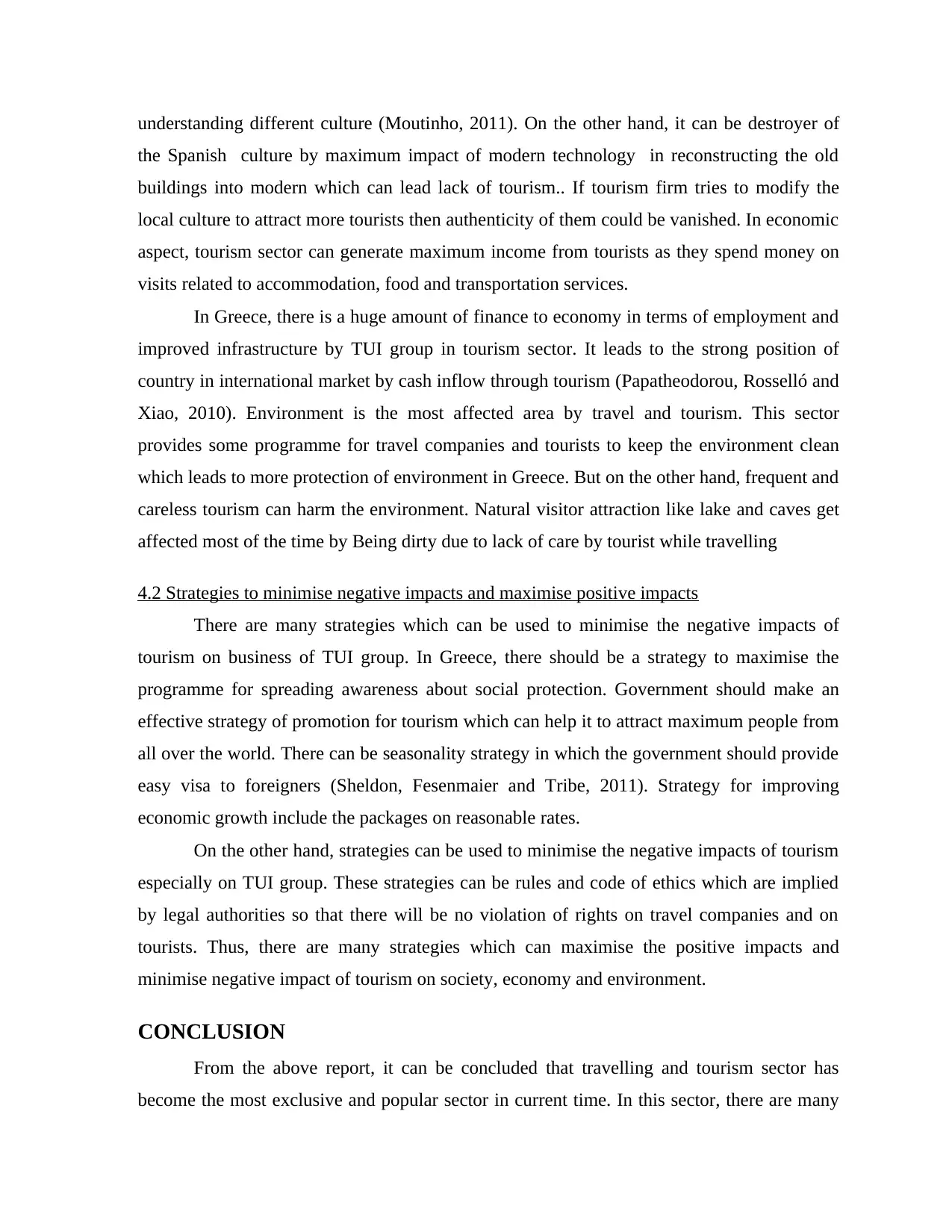
understanding different culture (Moutinho, 2011). On the other hand, it can be destroyer of
the Spanish culture by maximum impact of modern technology in reconstructing the old
buildings into modern which can lead lack of tourism.. If tourism firm tries to modify the
local culture to attract more tourists then authenticity of them could be vanished. In economic
aspect, tourism sector can generate maximum income from tourists as they spend money on
visits related to accommodation, food and transportation services.
In Greece, there is a huge amount of finance to economy in terms of employment and
improved infrastructure by TUI group in tourism sector. It leads to the strong position of
country in international market by cash inflow through tourism (Papatheodorou, Rosselló and
Xiao, 2010). Environment is the most affected area by travel and tourism. This sector
provides some programme for travel companies and tourists to keep the environment clean
which leads to more protection of environment in Greece. But on the other hand, frequent and
careless tourism can harm the environment. Natural visitor attraction like lake and caves get
affected most of the time by Being dirty due to lack of care by tourist while travelling
4.2 Strategies to minimise negative impacts and maximise positive impacts
There are many strategies which can be used to minimise the negative impacts of
tourism on business of TUI group. In Greece, there should be a strategy to maximise the
programme for spreading awareness about social protection. Government should make an
effective strategy of promotion for tourism which can help it to attract maximum people from
all over the world. There can be seasonality strategy in which the government should provide
easy visa to foreigners (Sheldon, Fesenmaier and Tribe, 2011). Strategy for improving
economic growth include the packages on reasonable rates.
On the other hand, strategies can be used to minimise the negative impacts of tourism
especially on TUI group. These strategies can be rules and code of ethics which are implied
by legal authorities so that there will be no violation of rights on travel companies and on
tourists. Thus, there are many strategies which can maximise the positive impacts and
minimise negative impact of tourism on society, economy and environment.
CONCLUSION
From the above report, it can be concluded that travelling and tourism sector has
become the most exclusive and popular sector in current time. In this sector, there are many
the Spanish culture by maximum impact of modern technology in reconstructing the old
buildings into modern which can lead lack of tourism.. If tourism firm tries to modify the
local culture to attract more tourists then authenticity of them could be vanished. In economic
aspect, tourism sector can generate maximum income from tourists as they spend money on
visits related to accommodation, food and transportation services.
In Greece, there is a huge amount of finance to economy in terms of employment and
improved infrastructure by TUI group in tourism sector. It leads to the strong position of
country in international market by cash inflow through tourism (Papatheodorou, Rosselló and
Xiao, 2010). Environment is the most affected area by travel and tourism. This sector
provides some programme for travel companies and tourists to keep the environment clean
which leads to more protection of environment in Greece. But on the other hand, frequent and
careless tourism can harm the environment. Natural visitor attraction like lake and caves get
affected most of the time by Being dirty due to lack of care by tourist while travelling
4.2 Strategies to minimise negative impacts and maximise positive impacts
There are many strategies which can be used to minimise the negative impacts of
tourism on business of TUI group. In Greece, there should be a strategy to maximise the
programme for spreading awareness about social protection. Government should make an
effective strategy of promotion for tourism which can help it to attract maximum people from
all over the world. There can be seasonality strategy in which the government should provide
easy visa to foreigners (Sheldon, Fesenmaier and Tribe, 2011). Strategy for improving
economic growth include the packages on reasonable rates.
On the other hand, strategies can be used to minimise the negative impacts of tourism
especially on TUI group. These strategies can be rules and code of ethics which are implied
by legal authorities so that there will be no violation of rights on travel companies and on
tourists. Thus, there are many strategies which can maximise the positive impacts and
minimise negative impact of tourism on society, economy and environment.
CONCLUSION
From the above report, it can be concluded that travelling and tourism sector has
become the most exclusive and popular sector in current time. In this sector, there are many
⊘ This is a preview!⊘
Do you want full access?
Subscribe today to unlock all pages.

Trusted by 1+ million students worldwide
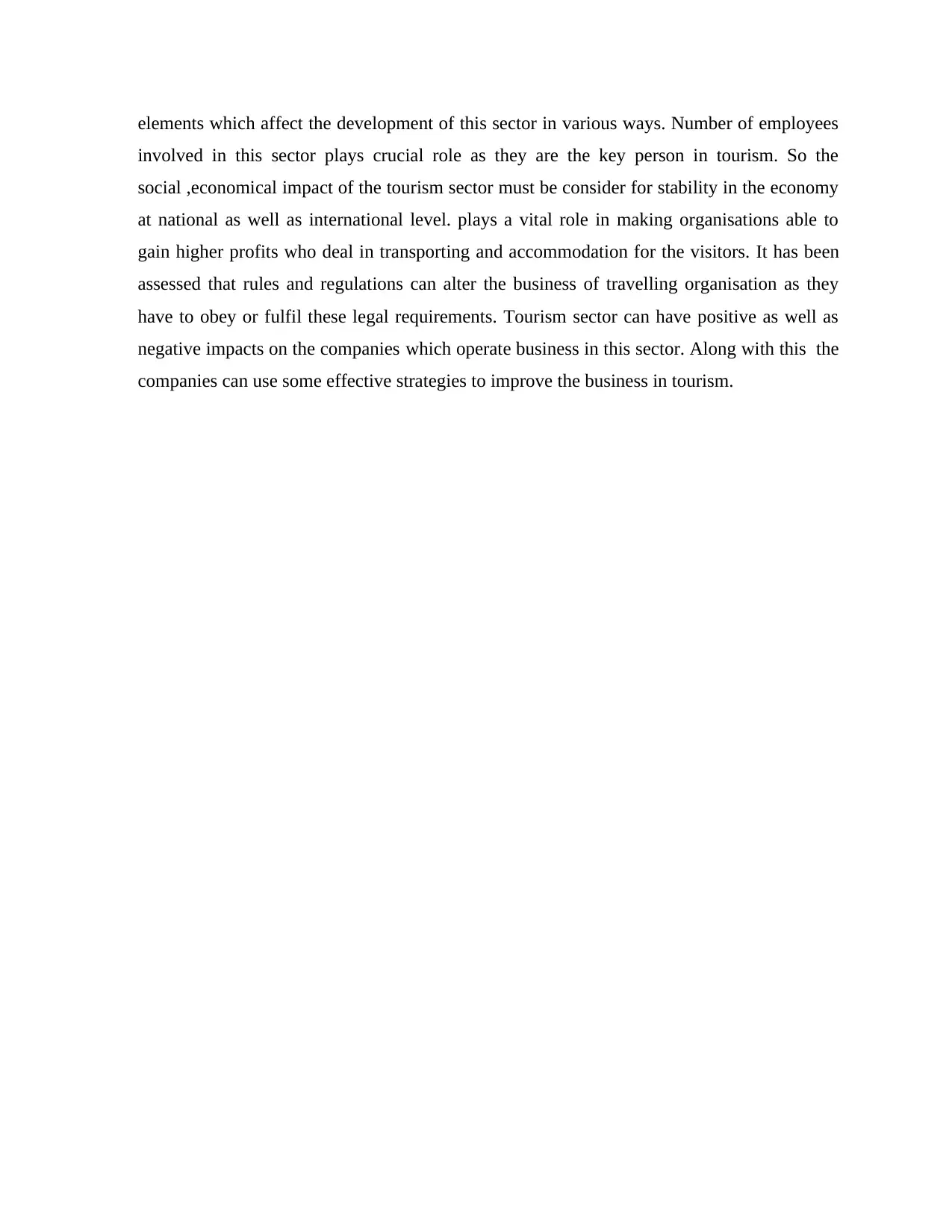
elements which affect the development of this sector in various ways. Number of employees
involved in this sector plays crucial role as they are the key person in tourism. So the
social ,economical impact of the tourism sector must be consider for stability in the economy
at national as well as international level. plays a vital role in making organisations able to
gain higher profits who deal in transporting and accommodation for the visitors. It has been
assessed that rules and regulations can alter the business of travelling organisation as they
have to obey or fulfil these legal requirements. Tourism sector can have positive as well as
negative impacts on the companies which operate business in this sector. Along with this the
companies can use some effective strategies to improve the business in tourism.
involved in this sector plays crucial role as they are the key person in tourism. So the
social ,economical impact of the tourism sector must be consider for stability in the economy
at national as well as international level. plays a vital role in making organisations able to
gain higher profits who deal in transporting and accommodation for the visitors. It has been
assessed that rules and regulations can alter the business of travelling organisation as they
have to obey or fulfil these legal requirements. Tourism sector can have positive as well as
negative impacts on the companies which operate business in this sector. Along with this the
companies can use some effective strategies to improve the business in tourism.
Paraphrase This Document
Need a fresh take? Get an instant paraphrase of this document with our AI Paraphraser
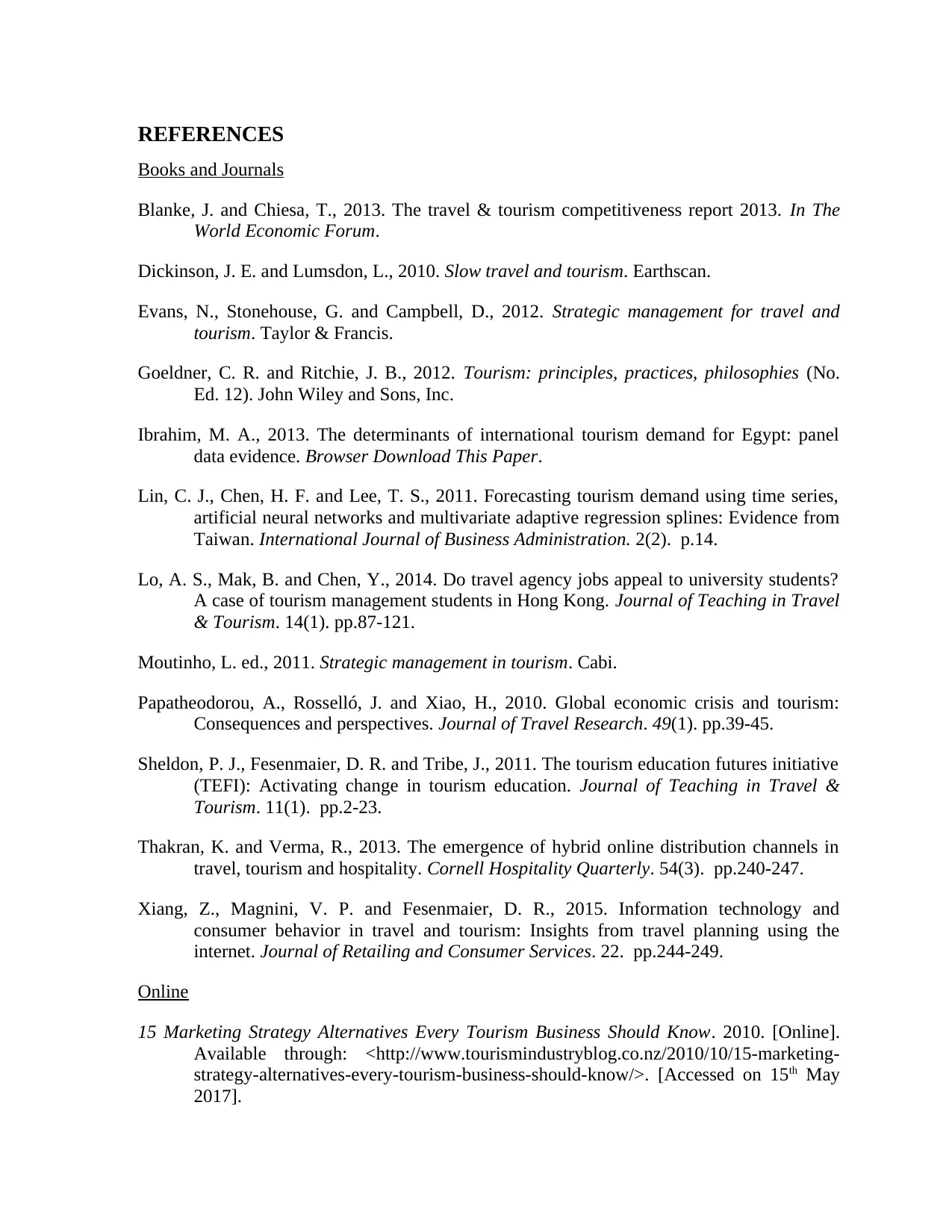
REFERENCES
Books and Journals
Blanke, J. and Chiesa, T., 2013. The travel & tourism competitiveness report 2013. In The
World Economic Forum.
Dickinson, J. E. and Lumsdon, L., 2010. Slow travel and tourism. Earthscan.
Evans, N., Stonehouse, G. and Campbell, D., 2012. Strategic management for travel and
tourism. Taylor & Francis.
Goeldner, C. R. and Ritchie, J. B., 2012. Tourism: principles, practices, philosophies (No.
Ed. 12). John Wiley and Sons, Inc.
Ibrahim, M. A., 2013. The determinants of international tourism demand for Egypt: panel
data evidence. Browser Download This Paper.
Lin, C. J., Chen, H. F. and Lee, T. S., 2011. Forecasting tourism demand using time series,
artificial neural networks and multivariate adaptive regression splines: Evidence from
Taiwan. International Journal of Business Administration. 2(2). p.14.
Lo, A. S., Mak, B. and Chen, Y., 2014. Do travel agency jobs appeal to university students?
A case of tourism management students in Hong Kong. Journal of Teaching in Travel
& Tourism. 14(1). pp.87-121.
Moutinho, L. ed., 2011. Strategic management in tourism. Cabi.
Papatheodorou, A., Rosselló, J. and Xiao, H., 2010. Global economic crisis and tourism:
Consequences and perspectives. Journal of Travel Research. 49(1). pp.39-45.
Sheldon, P. J., Fesenmaier, D. R. and Tribe, J., 2011. The tourism education futures initiative
(TEFI): Activating change in tourism education. Journal of Teaching in Travel &
Tourism. 11(1). pp.2-23.
Thakran, K. and Verma, R., 2013. The emergence of hybrid online distribution channels in
travel, tourism and hospitality. Cornell Hospitality Quarterly. 54(3). pp.240-247.
Xiang, Z., Magnini, V. P. and Fesenmaier, D. R., 2015. Information technology and
consumer behavior in travel and tourism: Insights from travel planning using the
internet. Journal of Retailing and Consumer Services. 22. pp.244-249.
Online
15 Marketing Strategy Alternatives Every Tourism Business Should Know. 2010. [Online].
Available through: <http://www.tourismindustryblog.co.nz/2010/10/15-marketing-
strategy-alternatives-every-tourism-business-should-know/>. [Accessed on 15th May
2017].
Books and Journals
Blanke, J. and Chiesa, T., 2013. The travel & tourism competitiveness report 2013. In The
World Economic Forum.
Dickinson, J. E. and Lumsdon, L., 2010. Slow travel and tourism. Earthscan.
Evans, N., Stonehouse, G. and Campbell, D., 2012. Strategic management for travel and
tourism. Taylor & Francis.
Goeldner, C. R. and Ritchie, J. B., 2012. Tourism: principles, practices, philosophies (No.
Ed. 12). John Wiley and Sons, Inc.
Ibrahim, M. A., 2013. The determinants of international tourism demand for Egypt: panel
data evidence. Browser Download This Paper.
Lin, C. J., Chen, H. F. and Lee, T. S., 2011. Forecasting tourism demand using time series,
artificial neural networks and multivariate adaptive regression splines: Evidence from
Taiwan. International Journal of Business Administration. 2(2). p.14.
Lo, A. S., Mak, B. and Chen, Y., 2014. Do travel agency jobs appeal to university students?
A case of tourism management students in Hong Kong. Journal of Teaching in Travel
& Tourism. 14(1). pp.87-121.
Moutinho, L. ed., 2011. Strategic management in tourism. Cabi.
Papatheodorou, A., Rosselló, J. and Xiao, H., 2010. Global economic crisis and tourism:
Consequences and perspectives. Journal of Travel Research. 49(1). pp.39-45.
Sheldon, P. J., Fesenmaier, D. R. and Tribe, J., 2011. The tourism education futures initiative
(TEFI): Activating change in tourism education. Journal of Teaching in Travel &
Tourism. 11(1). pp.2-23.
Thakran, K. and Verma, R., 2013. The emergence of hybrid online distribution channels in
travel, tourism and hospitality. Cornell Hospitality Quarterly. 54(3). pp.240-247.
Xiang, Z., Magnini, V. P. and Fesenmaier, D. R., 2015. Information technology and
consumer behavior in travel and tourism: Insights from travel planning using the
internet. Journal of Retailing and Consumer Services. 22. pp.244-249.
Online
15 Marketing Strategy Alternatives Every Tourism Business Should Know. 2010. [Online].
Available through: <http://www.tourismindustryblog.co.nz/2010/10/15-marketing-
strategy-alternatives-every-tourism-business-should-know/>. [Accessed on 15th May
2017].
1 out of 8
Related Documents
Your All-in-One AI-Powered Toolkit for Academic Success.
+13062052269
info@desklib.com
Available 24*7 on WhatsApp / Email
![[object Object]](/_next/static/media/star-bottom.7253800d.svg)
Unlock your academic potential
Copyright © 2020–2025 A2Z Services. All Rights Reserved. Developed and managed by ZUCOL.





